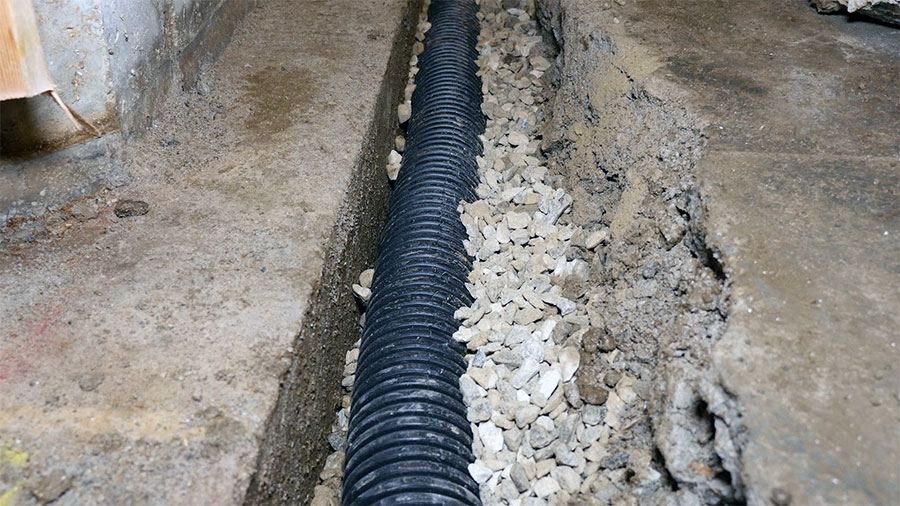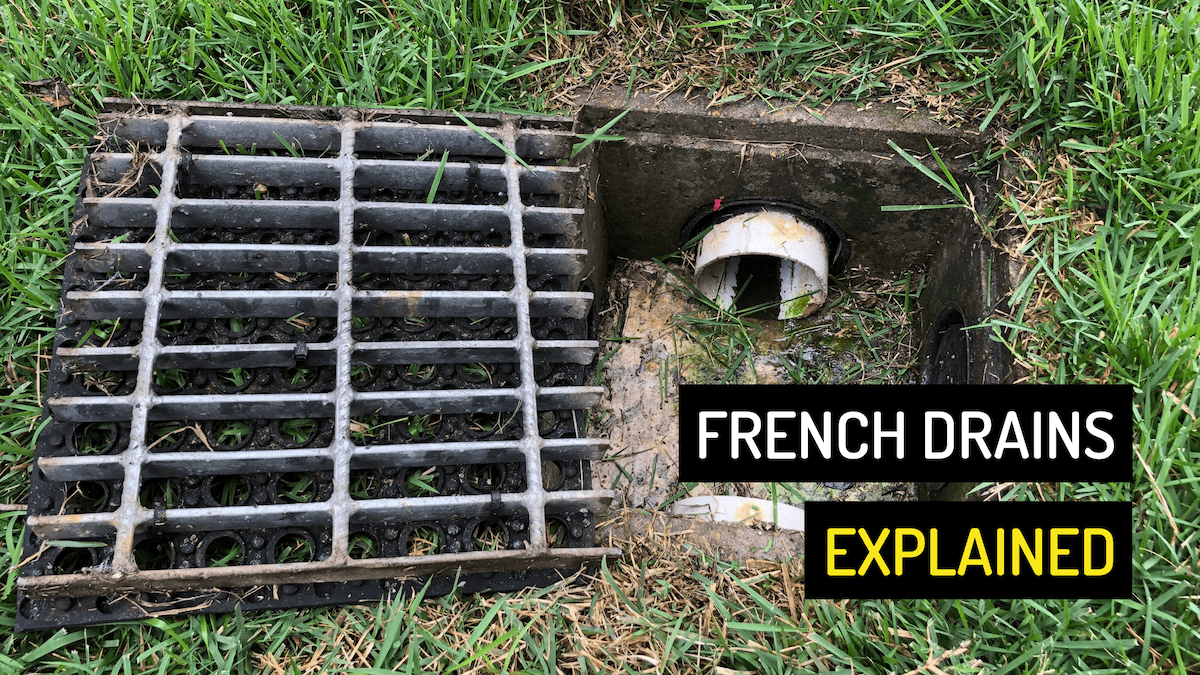The Important Guide to Maintaining Your French Drain for Resilient Efficiency
Maintaining your French drain is crucial to its efficiency and your residential or commercial property's security. Regular checks can save you from costly repair services and water damage. You'll would like to know what indications to look for and just how frequently to examine your system. Plus, comprehending the cleaning procedure can make a substantial distinction. Let's discover the essential steps for guaranteeing your drainpipe functions well for many years to find.
Recognizing the Feature of a French Drain
A French drainpipe is an important element in taking care of water around your home. It routes excess water away from your structure, preventing flooding and damage. When heavy rain drops, the drain gathers water through a perforated pipe buried in gravel. This system permits water to flow openly, minimizing pressure on your cellar walls and decreasing the threat of leaks.You could ask yourself how it works in practice. As water saturates the dirt, gravity pulls it toward the drain. The perforated pipe catches this water, delivering it to a designated drain area or storm sewer. This process maintains your backyard completely dry and secures your home's structural integrity.Understanding exactly how a French drainpipe functions is key to appreciating its value. By successfully directing water away, it aids maintain a completely dry and safe living atmosphere. So, maintaining your French drain in top problem assurances you stay clear of pricey repair services down the line.
Routine Assessments: What to Search for
When you're examining your French drain, start by checking for any kind of obstructions that could be blocking water flow. Take note of indications of surface area disintegration around the drain, as this can indicate possible concerns. Normal assessments will help maintain your drain system functioning efficiently.
Blocked Drainpipe Evaluation
How can you inform if your French drain is blocked? Initially, expect water pooling in your backyard, especially after hefty rainfall. If you see locations where water accumulates as opposed to draining pipes, that's a red flag. You should likewise examine the drainpipe electrical outlet; if water isn't spurting as it should, there's likely a blockage. Pay attention for unusual gurgling noises, which can suggest trapped air. Furthermore, inspect the drainpipe's surface area for any kind of plant life development, as origins can block the system and penetrate. Finally, if you scent stuffy odors, it can indicate stagnant water brought on by a blockage. Regularly examining these indicators can aid you maintain your French drain effectively and protect against expensive repair work.
Surface Area Erosion Examine

Cleansing Your French Drainpipe: Step-by-Step Guide
Cleaning your French drainpipe is important for keeping it functioning properly. You'll need some certain devices and a clear process to ensure everything runs smoothly. Allow's walk with the steps and pointers for maintaining your drainpipe properly.
Devices You'll Require
To tackle the job of cleaning your French drainpipe efficiently, you'll wish to gather a few essential tools. Get hold of a durable set of handwear covers to secure your hands from particles and sharp things. A tiny shovel or trowel will certainly assist you get rid of dirt or blockages around the drain. For removing the interior, a plumbing technician's snake or a high-pressure water nozzle can be unbelievably valuable. You'll also need a bucket for collecting any type of particles you take out. Having a yard hose on hand will make it simpler to rinse out the drainpipe and ensure it's flowing efficiently. With these devices ready, you'll be set for a detailed cleansing session!
Cleaning Refine Actions
Begin by assessing the area around your French drain for any kind of visible particles or clogs. Get rid of leaves, branches, or dust that might block water flow. Next off, check the inlet and electrical outlet areas; clear any obstructions to ensure proper drainage. Make use of a garden pipe to flush the drainpipe, directing water right into the inlet. This assists displace any built up sludge or sediment. If you notice relentless blockages, consider utilizing a plumbing's serpent to break them up. After cleaning, inspect the crushed rock around the drainpipe; renew it if it's cleaned away. Verify the drain covers are intact and securely in location to stop debris from going into. Routine cleansing keeps your French drain functioning effectively.
Upkeep Regularity Tips
While regular upkeep is vital for your French drainpipe's longevity, recognizing how commonly to maintain it can make all the distinction. Preferably, you should evaluate your French drain at the very least twice a year, ideally in springtime and look at more info fall. After heavy rainfall or snowmelt, look for obstructions or debris. If you see any standing water, it's time to clean your drain.In areas with heavy vegetation, more frequent upkeep-- concerning every three months-- might be necessary. Furthermore, consider cleansing your French drain after significant storms or if you observe water merging in your yard. By staying aggressive, you'll guarantee your French drain functions efficiently and protects your property from water damage. Normal checks will certainly save you time and cash over time.
Recognizing Usual Concerns and Their Solutions
When you discover water merging in your backyard or damp places in your cellar, it's vital to recognize typical concerns with your French drain and implement efficient remedies. One constant problem is clogging, often brought on by particles like leaves or sediment. To fix this, you can use a plumbing serpent or a high-pressure water jet to clear blockages.Another issue may be improper incline. If your drain isn't sloped correctly, water won't move far from your home. You can change the incline by excavating and repositioning the drainpipe pipe.Lastly, look for damage or cracks in the drain itself. Changing the damaged sections is essential for peak performance if you discover any type of. By resolving these problems promptly, you'll help guarantee that your French drainpipe remains to work efficiently, shielding your residential or commercial property from water damage and preserving a completely dry, safe environment.
Seasonal Maintenance Tips for Your French Drain
Addressing typical issues with your French drain is simply the very first step in guaranteeing its long-term effectiveness. Seasonal maintenance is important for peak efficiency. In the spring, remove leaves and particles that may have accumulated during winter season. Inspect for any type of clogs in the electrical outlet or capture container, as water requires a clear course to move freely.During summer season, inspect your drain for any type of indications of changing or working out soil. Make sure it's still degree and working effectively. As loss approaches, clean any type of dropped delegates prevent blockages before winter months arrives.In winter season, expect freezing temperature levels. Make certain your drainpipe isn't at threat of cold if you live in a cool environment. Insulating subjected pipelines can assist. Routine checks and timely maintenance can stop expensive fixings and maintain your French drain working effectively year-round. Remain positive and enjoy comfort knowing your drainage system is in good condition!
When to Employ a Specialist
When to call in an expert can save you time and stop additional damages to your French drainpipe, knowing. It's a clear sign that your drain might be clogged or harmed if you discover persistent standing water in your yard. Don't neglect strange smells, as they can indicate sewer backup or decay, which needs prompt attention.If you find that your drain isn't working properly after attempts to tidy or preserve it, it's time to connect for specialist aid. In addition, if you're unclear concerning the underlying problems or lack the necessary devices, hiring a specialist can provide peace of mind.Finally, if your French drainpipe is old or has actually experienced significant wear and tear, expert assessment can determine whether repair services or full replacement is needed. Count on the professionals to ensure your water drainage system works efficiently for several years to come.
Tips for Preventing Future Drainage Troubles
To maintain your French drain functioning efficiently, consistently inspecting and maintaining it can make all the difference. Begin by removing particles, leaves, and dirt from Visit Your URL the surface and drainpipe openings. This stops blockages that can result in water backup. Inspect the gravel around the drain; if it's compacted or worn down, take into consideration including fresh gravel to maintain ideal flow.Next, divert water away from your drain by making certain gutters and downspouts are clear and guiding water a minimum of 3 feet far from your foundation. Frequently inspect for any indicators of damage or sagging. If you notice issues, resolve them immediately.Finally, think about setting up a catch or a filter basin to trap larger debris before it gets in the drain. By staying positive with these suggestions, you'll reduce the danger of future drain troubles and maintain your French drainpipe in leading form.
Frequently Asked Questions
The length of time Does a French Drainpipe Commonly Last?
A French drainpipe typically lasts around 30 to 40 years, depending on the materials used and maintenance (Portland French Drain). If you keep up with routine checks, you can prolong its life expectancy also additionally
Can I Set Up a French Drain Myself?
Yes, you can install a French drain yourself if you have actually obtained the right devices and understanding. Just make certain to plan thoroughly, follow neighborhood laws, and warranty appropriate drain to avoid future issues.
What Products Are Utilized in a French Drain?
You'll need perforated pipeline, crushed rock, landscape material, and a solid water drainage pipeline for your French drain. These materials aid reroute water effectively, avoiding flooding and keeping your building safe and dry from water damages.

Is an Authorization Required to Install a French Drain?
You'll likely require an authorization to install a French drain, depending upon regional laws. Check with your community to assure you abide by any type of needed standards and stay clear of potential issues throughout installment.
What Are the Costs Related To French Drainpipe Upkeep?
Maintaining a French drain normally sets you back in between $100 and $500 every year. You'll need to take right into account expenditures for cleaning, repair services, and assessments. Routine maintenance aids protect against bigger costs and guarantees your system works correctly for years - Portland French Drain. When you're inspecting your French drainpipe, begin by inspecting for any type of blockages that may be obstructing water flow. By remaining aggressive, you'll ensure your French drain functions effectively and protects your residential property from water damages. When you notice water merging in your lawn or damp places in your basement, it's vital to recognize common concerns with your French drain and implement reliable services. You can readjust the incline by digging and rearranging the drain pipe.Lastly, check for damages or cracks in the drainpipe itself. Check the crushed rock around the drain; if it's compressed find out this here or eroded, take into consideration adding fresh crushed rock to maintain optimal flow.Next, draw away water away from your drain by making sure gutters and downspouts are clear and directing water at least three feet away from your structure